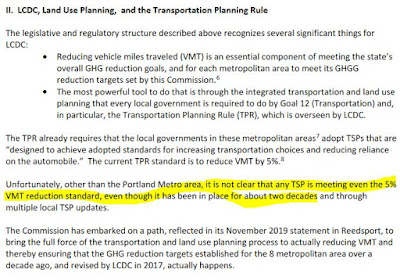 |
| Front page today in the Oregonian |
Last week at the meeting of the LCDC (the oversight board for DLCD, like the OTC is to ODOT), staff briefed the board on the Statewide Transportation Strategy and Related Land Use Actions. The STS, you may recall, is about emissions. (Full meeting agenda and packet here. Recent previous notes on the STS here and here.)
Public comment on the Staff Report highlighted a serious omission: The Staff Report did not mention less driving and reducing VMT. Here's 1000 Friends on this.
 |
| 1000 Friends say we aren't talking about VMT reduction |
 |
| 1000 Friends say the MPOs and cities are failing |
 |
| To note, but not actually to do anything about |
On Traffic Forecasting: Margin of Error, Descriptive, and Prescriptive Methods
Also on the agenda is the formal workplan for SKATS. One of the main parts is on forecasting and "refinement."
 |
| As SKATS works to "refine" traffic forecasting they should include error and uncertainty. Draft 2020 Work Plan (chart and comments added) |
First, SKATS needs to push out to planners, consultants, and electeds real statements of uncertainty and margin of error in all forecasts.
Second, in line with the STS, SKATS should consider split forecasting, with two paths, one that is descriptive and embodies current practices, the other that is prescriptive and includes the VMT reductions from the STS.
We need to start planning for the future we want to have, not for the future we hope we will get if we remain oblivious. Our current modes of forecasting erase calls for VMT reduction and this is untenable. We need to highlight the gap between the future we are creating and the future we need to create.
On Bad Data Sources
 |
| "Free flow travel speeds...exceed the posted speed limit" From a 2015 INRIX report and comment from City Observatory |
More than this, the basic frame of "congestion" and its solution of "free flow" cannot coexist with a basic frame devoted to VMT reduction and GHG reduction. Each frame optimizes with different conditions and they are incompatible. The MPO should face this.
On Safety
 |
| With safety our data collection seems robust, but we don't act on it |
 |
| Memorial to Ronald Drolshagen in mid-January State and Front at the Carousel Killed in the crosswalk on December 4th |
 |
| Look for the historic sign next to the entry |
SKATS Policy Committee Committee meets Tuesday the 28th, at noon. SKATS is at 100 High St. SE, Suite 200, above Table Five 08 and Epilogue Kitchen.


1 comment:
Error bars are not enough to change behavior of a planning bureaucracy. What would be required is An administrative rule or statute that the body making a forecast cannot publish a forecast or rely on it until they do a retrospective analysis of past predictions and come up with their error tendencies, which would then be required to be included in any subsequent forecasts.
This is what sailors do when dead reckoning: keep track of where they think they are and where they think they’re going and then, whenever they get an accurate external fix, they compare the error between where they thought they were and where they actually turned out to be and they assume that they will continue to make those same errors at the same rates until the next fix is obtained. It forces the sailor to be conservative and avoids deluding yourself because you want the desired outcome to be something favorable so badly but you ignore your own tendency to make mistakes and predictions to give you what you think you desire.
Virtually every part of government makes predictions and produces a track record of performance against predicted results, so the same process can be used.
I know of no government that actually incorporates that knowledge into its conduct. But it’s especially appropriate in transportation planning, both for budget predictions and for traffic predictions that drive project decisions. If we required agencies to compute their own error rates and apply them to projects Such that they couldn’t produce lowball estimate of costs in order to win voter approval, they suddenly have a whole new interest in actually forecasting reality.
Post a Comment